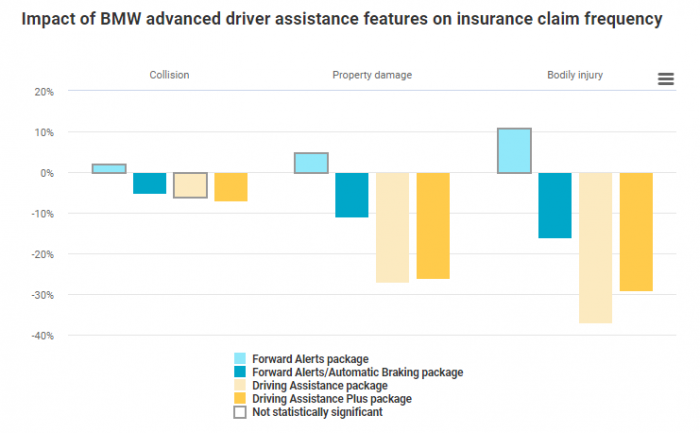The Highway Loss Data Institute (HDLI) has completed a new study of the effectiveness of the driver-assist safety systems featured in BMW vehicles from model years 2013-17. The study was comprehensive, having a total exposure, or sample size, of nearly 6 million insured vehicle years.
The main conclusion of the study is that the newer, more advanced systems offered by BMW result in "...large reductions in the frequency of property damage liability and bodily injury liability claims." In other words, the active safety systems in BMW cars will mean drivers have lower insurance claims costs.

"The crash claim frequency reductions for BMW's Driving Assistance package are the largest we've seen from advanced driver assistance systems, which suggests crash avoidance may be delivering bigger benefits as the technology improves," says Matt Moore, senior vice president of HLDI. "The lane centering that comes in the 'plus' package doesn't seem to augment these benefits. That may be because the system is only intended for use on freeways, which are comparatively safer than other roads, and only works when the driver switches it on."
BMW Forward Collision Prevention and Adaptive Cruise Control
BMW's forward collision prevention can help prevent an accident, and can also help make an accident less severe in some cases. It is coupled with adaptive cruise control which allows a driver to follow a car in front of them and match its speed. However, the study found that there was a vast difference in the effectiveness of the BMW active safety systems depending on which the driver had. There are multiple versions.
The basic system basically did nothing of any value. The study concluded, "BMW's most basic package, which includes only forward collision warning and lane departure warning, was associated with a 2 percent increase in the frequency of collision claims, a 5 percent increase in the frequency of property damage claims and an 11 percent increase in the frequency of bodily injury claims. None of these results was statistically significant, and they differed from HLDI's studies of similar systems from other manufacturers."
However, the advanced system had a very meaningful accident claim reduction. HDLI's study found that the BMW Driving Assistance package — which has an upgraded version of active safety systems and also adaptive cruise control — "reduced collision, property damage and bodily injury claim rates by 6 percent, 27 percent and 37 percent, respectively."
Lane Centering Is Not A Safety Feature
Although the BMW advanced safety package does an admiral job of helping to reduce accident claim costs, one feature had no meaningful impact according to Matt Moore, senior vice president of HLDI. "The lane centering that comes in the 'plus' package doesn't seem to augment these benefits. That may be because the system is only intended for use on freeways, which are comparatively safer than other roads, and only works when the driver switches it on."
Read more details on this study at the HDLA website.
If you are shopping for a new or used vehicle, how important are active safety systems to you? Tell us in the comments below.
John Goreham is a life-long car nut and recovering engineer. John's focus areas are technology, safety, and green vehicles. In the 1990s, he was part of a team that built a solar-electric vehicle from scratch. His was the role of battery thermal control designer. For 20 years he applied his engineering and sales talents in the high tech world and published numerous articles in technical journals such as Chemical Processing Magazine. In 2008 he retired from that career to chase his dream of being an auto writer. In addition to Torque News, John's work has appeared in print in dozens of American newspapers and he provides reviews to many vehicle shopping sites. You can follow John on Twitter, and view his credentials at Linkedin.
Top of page image courtesy of BMW media support. Chart courtesy of HDLI.












Comments
Lane departure/centering is
Permalink
Lane departure/centering is the single most annoying feature on today's modern vehicles!
One of the only things I don
Permalink
In reply to Lane departure/centering is by Jimmy Dinsmore
One of the only things I don't like about my Forester is that I cannot shut off the lane departure warning. And I purposefully added the driver assist package to get the forward collision prevention.
Every auto manufacture has
Permalink
Every auto manufacture has managed to include "safety" features that are both ineffective and annoying. Until I can order a la carte, avoiding the annoying, I'll not be purchasing their undesirable, irritating, vehicles. Don't understand why a knowledgeable auto journalist (JG) would do otherwise.
When EyeSight came out it was
Permalink
In reply to Every auto manufacture has by Mark Day (not verified)
When EyeSight came out it was the first really effective forward collision prevention system in an affordable vehicle. It is also the best system at any price in many comparison tests. So, in 2016 I paid about $27K for a car with a technology I wanted. Sadly, I had to take the lane departure system (which I call "Beep-You should have killed the jogger") with it. I also had to take a huge panoramic sunroof, which I do not prefer, to get the heated seats and windshield. I do wish I could pick and choose only what I want. No manufacturer of affordable cars offers that in my experience. It's a bummer.
Perhaps the new Subarus, and
Permalink
In reply to When EyeSight came out it was by John Goreham
Perhaps the new Subarus, and others, should have, as standard equipment, a large roll of electrical tape. A friend recently purchase a new Subaru and has been busy taping over various sensors to stop the nagging. I'm not buying new, with or without the roll of tape.